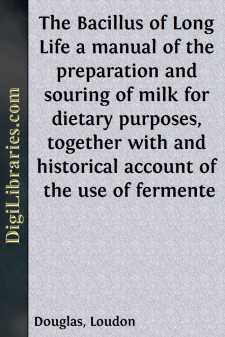Categories
- Antiques & Collectibles 13
- Architecture 36
- Art 48
- Bibles 22
- Biography & Autobiography 813
- Body, Mind & Spirit 142
- Business & Economics 28
- Children's Books 17
- Children's Fiction 14
- Computers 4
- Cooking 94
- Crafts & Hobbies 4
- Drama 346
- Education 46
- Family & Relationships 57
- Fiction 11829
- Games 19
- Gardening 17
- Health & Fitness 34
- History 1377
- House & Home 1
- Humor 147
- Juvenile Fiction 1873
- Juvenile Nonfiction 202
- Language Arts & Disciplines 88
- Law 16
- Literary Collections 686
- Literary Criticism 179
- Mathematics 13
- Medical 41
- Music 40
- Nature 179
- Non-Classifiable 1768
- Performing Arts 7
- Periodicals 1453
- Philosophy 64
- Photography 2
- Poetry 896
- Political Science 203
- Psychology 42
- Reference 154
- Religion 513
- Science 126
- Self-Help 84
- Social Science 81
- Sports & Recreation 34
- Study Aids 3
- Technology & Engineering 59
- Transportation 23
- Travel 463
- True Crime 29
The Bacillus of Long Life a manual of the preparation and souring of milk for dietary purposes, together with and historical account of the use of fermente
by: Loudon Douglas
Description:
Excerpt
CHAPTER I
INTRODUCTORY—HISTORICAL
The milk industry is one of the oldest known to mankind, and it is difficult to imagine a time when milk in one way or another did not form a part of the diet of the human race. There is a good deal of evidence to show that in Paleolithic and Neolithic times, cattle were part of the possessions of the nomadic races; and, according to the Vedas, the manufacture of butter was known in India 1500 years B.C.
In the eastern part of Europe, milk has always been looked upon as one of the principal kinds of food, but not necessarily the milk of cows, as, from ancient times to the present day, the milk from camels, buffaloes, sheep, and goats has been used indiscriminately throughout the East.
According to Layard, "the Bedouins do not make cheese. The milk of their sheep and goats is shaken into butter or turned into curds; it is rarely or never drunk fresh, new milk being thought very unwholesome, as soon by experience I found it to be, in the desert. I have frequently had occasion to describe the process of making butter by shaking the milk in skins. This is also an employment confined to women, and one of a very laborious nature. The curds are formed by boiling the milk, and then putting some curds made on the previous day into it and allowing it to stand. When the sheep no longer give milk, some curds are dried, to be used as a leaven on a future occasion. This preparation, called leben, is thick and acid, but very agreeable and grateful to the taste in a hot climate. The sour milk, or sheneena, a universal beverage amongst the Arabs, is either buttermilk pure and diluted, or curds mixed with water.
The Pass of Bukova.—During the revolution of 1904, a number of Turkish soldiers, just before traversing this pass, were given coffee containing "café" by a Bulgarian coffee-seller, or keeper of a small khan. Whilst in the pass the poison began to take effect, and they realized that they had been poisoned. Fortunately for them, a peasant with three horses loaded with Yoghourt (soured milk) had taken advantage of their escort. The soldiers ate freely of the Yoghourt, which counteracted the effects of the poison.
"The camel's milk is drunk fresh. It is pleasant to the taste, rich, and exceedingly nourishing. It is given in large quantities to the horses. The Shammar and Aneyza Bedouins have no cows or oxen, those animals being looked upon as the peculiar property of tribes who have forgotten their independence, and degraded themselves by the cultivation of land. The sheep are milked at dawn, or even before daybreak, and again in the evening on their return from the pastures. The milk is immediately turned into leben, or boiled to be shaken into butter. Amongst the Bedouins and Jebours it is considered derogatory to the character of a man to milk a cow or sheep, but not to milk the camel. The Sheikhs occasionally obtain dates from the cities. They are eaten dry with bread and leben, or fried in butter, a very favourite dish of the Bedouin...."
The practice is now the same as it was in scriptural times, when milk was looked upon as the principal article of diet, and throughout the Scriptures there are copious references to milk in different forms, some of which are of peculiar interest at the present day....


